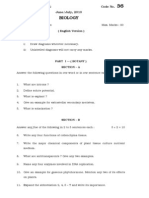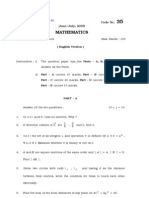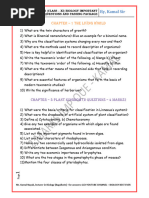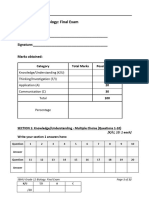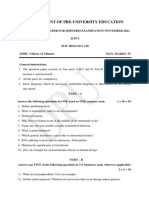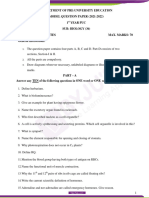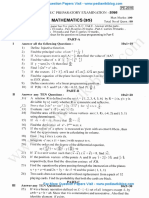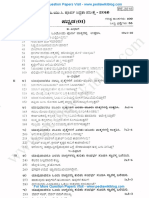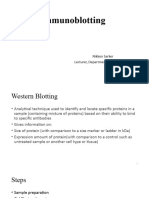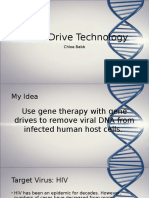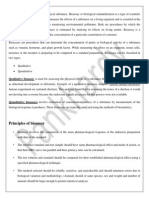Biology Mar 2009 Eng
Biology Mar 2009 Eng
Uploaded by
Prasad C MCopyright:
Available Formats
Biology Mar 2009 Eng
Biology Mar 2009 Eng
Uploaded by
Prasad C MCopyright
Available Formats
Share this document
Did you find this document useful?
Is this content inappropriate?
Copyright:
Available Formats
Biology Mar 2009 Eng
Biology Mar 2009 Eng
Uploaded by
Prasad C MCopyright:
Available Formats
Total No.
of Questions : 42
Code No. March, 2009
36
BIOLOGY
Time : 3 Hours 15 Minutes ( English Version ) Instructions : i) ii) Draw diagrams wherever necessary. Unlabelled diagrams do not get any marks. Max. Marks : 90
PART I ( BOTANY ) PART A Answer the following questions in one word or in one sentence each : 5 1=5 1. 2. 3. 4. 5. Name the pentose sugar present in RNA. Name the living mechanical tissue in plants. Define imbibition. State Blackmans law of limiting factors. Name the hormone responsible for Richmond-Lang effect in plants. PART B Answer any five of the following in 2 to 5 sentences each : 6. 7. 8. 9. Differentiate between sense and anti-sense strands of DNA. What is recombinant DNA technology ? Mention two applications of it. Mention the differences between parenchyma and sclerenchyma. What is transpiration ? Mention two types. 5 2 = 10
10. Mention two physiological functions of Abscissic acid. 11. Mention two commercial applications of NAA ( Naphthalene Acetic Acid ). PART C Answer any four of the following in about 200 to 250 words each wherever applicable : 12. Explain the semi-conservative method of DNA replication. 4 5 = 20
13. Explain the steps involved in DNA fingerprinting technique. 14. Explain the structure of pUC-18 with a labelled diagram. 15. With labelled diagrams, explain the kinds of xylem vessels ( tracheae ) based on their lignification. 16. Explain transpiration pull theory of ascent of sap. Mention any two merits of it. 17. What is Pasteurs effect ? Explain any four external factors affecting the rate of respiration. PART D I. Answer any one of the following : 18. Give the schematic representation of Calvin cycle. 19. Give reasons for the following in one sentence each : a) b) c) d) e) Genetic code is universal. Golden rice is yellowish in colour. As the wind blows, rate of ascent of sap increases. RQ value of proteins is generally less than 1. Carotenoid and Xanthophyll are called accessory photosynthetic pigments. ( Questions only from the Practical syllabus ) II. Answer any one of the following : 20. a) 1 5=5 1 5=5 5 5 1=5
Draw a neat labelled diagram of the vascular bundle of young Monocot stem to show the anatomical details. 4 1
b) 21. a)
Dorsiventral leaf is also called hypostomatic leaf. Why ?
Describe an experiment to demonstrate unequal transpiration in plants. 4
b)
The addition of limewater to water in an experimental set-up with aquatic plants decreases the amount of oxygen released. Why? 1
PART II ( ZOOLOGY ) PART E Answer the following questions in one word or one sentence each : 5 1=5 22. Mention the phenotypic ratio of a dihybrid cross. 23. What is afforestation ? 24. Name the hyperglycemic factor. 25. Define stroke volume. 26. Name the organic connection between the mother and the foetus that helps in physiological exchange. PART F Answer any five of the following in about 2 to 5 sentences each : 5 2 = 10 27. Differentiate between genetic diversity and habitat diversity. 28. What is soil erosion ? Mention two causes of soil erosion. 29. Mention the possible blood groups of the progeny whose mother is heterozygous for A group and father is heterozygous for B group. 30. What are narcotic drugs ? Mention two examples for hallucinogens. 31. What is rhinitis ? Mention two symptoms of it. 32. List the differences between spermatogenesis and oogenesis. PART G Answer any four of the following in about 200 to 250 words each wherever applicable : 4 5 = 20
33. State the law of segregation. Explain the monohybrid cross in Pisum Sativum ( Garden pea ). 34. What is biodiversity depletion ? Explain any four anthropocentric causes of biodiversity depletion. 35. Explain the role of any five enzymes in protein digestion.
36. What are surface barriers ? Explain the role of skin and mucus membrane as bodys first line of defence. 37. Define blood clotting. Explain Best and Taylors theory of mechanism of blood clotting. 38. Explain the steps involved in urine formation. PART H I. Answer any one of the following : 1 5=5
39. Draw a neat diagram of the human sperm and label the following parts : Distal centriole, main piece of tail, Axoneme, Nebenkern, Nucleus, Acrosome, Proximal centriole, Neck. 40. Give reasons for the following in one sentence each : a) b) Hypertrichosis is seen only in males. Accumulation of CO2 warming. c) d) e) Human heart is myogenic. FSH is a gametokinetic factor. Cleavage in frogs egg results in unequal blastomeres. ( Questions only from the Practical syllabus ) II. Answer any one of the following : 41. a) 1 5=5 in the atmosphere results in global 5 5 1=5
Draw a neat diagram of the T.S. of the hepatic lobule and label the following : Hepatic triad, Hepatic cord, Sinusoids, Central vein, Hepatic artery, Hepatocyte. 4 1 4
b) 42. a) b)
Name the connective tissue covering of liver. Draw a neat labelled diagram of a multipolar neuron.
Name the biochemical test to detect the presence of glucose in urine sample of a diabetic. 1
You might also like
- Chapter 1: Biology: Exploring LifeDocument5 pagesChapter 1: Biology: Exploring LifeThalia Lau100% (1)
- Mol 214 Lab Report #1Document5 pagesMol 214 Lab Report #1Samuel RobertsNo ratings yet
- Biology March 2006 EngDocument3 pagesBiology March 2006 EngPrasad C MNo ratings yet
- Biology (Part Ii) - Zoology: Code No. March / April, 2006Document3 pagesBiology (Part Ii) - Zoology: Code No. March / April, 2006Prasad C MNo ratings yet
- Biology EngDocument4 pagesBiology EngPrasad C M0% (1)
- BiologyDocument6 pagesBiologyArchanaNo ratings yet
- I Puc Annual - BiologyDocument14 pagesI Puc Annual - BiologydanielakhilkumarNo ratings yet
- Mathematics March 2008 EngDocument7 pagesMathematics March 2008 EngPrasad C MNo ratings yet
- Mathematics: Code No. June/July, 2010Document8 pagesMathematics: Code No. June/July, 2010Prasad C MNo ratings yet
- Mathematics July 2009 EngDocument8 pagesMathematics July 2009 EngPrasad C M50% (2)
- Mathematics June 2008 EngDocument8 pagesMathematics June 2008 EngPrasad C MNo ratings yet
- Mathematics March 2007 EngDocument7 pagesMathematics March 2007 EngPrasad C MNo ratings yet
- Chemistry March 2008 EngDocument7 pagesChemistry March 2008 EngPrasad C M0% (2)
- Computer Science Mar 2009Document4 pagesComputer Science Mar 2009Prasad C MNo ratings yet
- Mathematics March 2006 EngDocument7 pagesMathematics March 2006 EngPrasad C M100% (2)
- Chemistry March 2007 EngDocument7 pagesChemistry March 2007 EngPrasad C MNo ratings yet
- Ipu 2marks Imp Bio KMNDocument8 pagesIpu 2marks Imp Bio KMNRaghavendra PejavarNo ratings yet
- Physics July 2009 EngDocument7 pagesPhysics July 2009 EngPrasad C MNo ratings yet
- Chemistry Mar 2009 EngDocument8 pagesChemistry Mar 2009 EngPrasad C M100% (1)
- SBI4U Final Exam (Student Version)Document12 pagesSBI4U Final Exam (Student Version)7979spamemailNo ratings yet
- Physics Mar 2009 EngDocument8 pagesPhysics Mar 2009 EngPrasad C M50% (2)
- I PUC-quarterly Test Model Paper-ChemistryDocument2 pagesI PUC-quarterly Test Model Paper-ChemistryrashmiNo ratings yet
- (TS) Junior Botany Ipe Pre Final Examination (Batch-Ii) 16-04-2022Document2 pages(TS) Junior Botany Ipe Pre Final Examination (Batch-Ii) 16-04-2022xxxxxxNo ratings yet
- Physics June 2008 EngDocument8 pagesPhysics June 2008 EngPrasad C MNo ratings yet
- Physics EngDocument8 pagesPhysics EngPrasad C MNo ratings yet
- Second Puc Biology Model Question Paper 2013 New Syllabus Subject Code: 36Document0 pagesSecond Puc Biology Model Question Paper 2013 New Syllabus Subject Code: 36Prasad C MNo ratings yet
- TOPICAL TEST 1: Whole NumbersDocument5 pagesTOPICAL TEST 1: Whole NumbersDiana AustinNo ratings yet
- Physics March 2006 EngDocument8 pagesPhysics March 2006 EngPrasad C MNo ratings yet
- Logic July 2009 EngDocument3 pagesLogic July 2009 EngPrasad C MNo ratings yet
- Annual Question Paper of Physics 2015Document3 pagesAnnual Question Paper of Physics 2015Balesh VantamuriNo ratings yet
- Tighe Math 151 Exam I A FA 14Document5 pagesTighe Math 151 Exam I A FA 14UMBCCalculusNo ratings yet
- Bio Practice SBI4UDocument16 pagesBio Practice SBI4Uitsraman46No ratings yet
- Sample Question Paper - Applied Mathematics-12054Document4 pagesSample Question Paper - Applied Mathematics-12054Jackson Anthony100% (1)
- Bio 102 Quiz QuestionsDocument20 pagesBio 102 Quiz Questionsshellers24No ratings yet
- Class 9Document8 pagesClass 9c88532790No ratings yet
- (TS) Junior Zoology Pre Final Examination (Batch - Ii) (19-04-2022)Document3 pages(TS) Junior Zoology Pre Final Examination (Batch - Ii) (19-04-2022)xxxxxxNo ratings yet
- Biology EngDocument4 pagesBiology EngPrasad C MNo ratings yet
- Model Question Paper: Iind Puc - BiologyDocument2 pagesModel Question Paper: Iind Puc - Biologygowthami_blNo ratings yet
- 1st PU Biology Model Question Papers 2013Document1 page1st PU Biology Model Question Papers 2013Prasad C M67% (6)
- 2nd Puc Biology Preparatory Exam Question Paper 2011Document2 pages2nd Puc Biology Preparatory Exam Question Paper 2011Bandaru Srinivas BabuNo ratings yet
- 5 6111520750315767596Document2 pages5 6111520750315767596Shivacharan HollaNo ratings yet
- Instructions A,:: 1. This Question Paper Consists of Four Parts B, and 0Document4 pagesInstructions A,:: 1. This Question Paper Consists of Four Parts B, and 0Girish M NNo ratings yet
- Ii Puc Midterm Question PaperDocument3 pagesIi Puc Midterm Question PaperPrajwal dNo ratings yet
- Kseeb I Puc Biology - EM Model Paper 2022Document4 pagesKseeb I Puc Biology - EM Model Paper 2022deekshithdeekshi65No ratings yet
- 11563277054Document2 pages11563277054nogavim466No ratings yet
- SSLC Science 5 Model Question Papers English MediumDocument41 pagesSSLC Science 5 Model Question Papers English MediumGobinath DhanaNo ratings yet
- Ii Pu Biology QPDocument6 pagesIi Pu Biology QPShambu BanavasiNo ratings yet
- 2nd PUC Biology Mid Term Nov 2015 PDFDocument1 page2nd PUC Biology Mid Term Nov 2015 PDFPrasad C M78% (9)
- Section IDocument2 pagesSection IOpenaiNo ratings yet
- 2009 ICSE Biology Question PaperDocument22 pages2009 ICSE Biology Question PaperBimal K. ChetriNo ratings yet
- First Pu Model Paper PDFDocument5 pagesFirst Pu Model Paper PDFMujeeb KhanNo ratings yet
- Prelims II Dec-24 (Bio)Document4 pagesPrelims II Dec-24 (Bio)premtote53No ratings yet
- Department of Pre-University EducationDocument2 pagesDepartment of Pre-University EducationMegha S.PNo ratings yet
- BIOLOGY (Preparatory 2021) (1)Document2 pagesBIOLOGY (Preparatory 2021) (1)mukta.p22357No ratings yet
- bio 2020Document7 pagesbio 2020boy144111No ratings yet
- Botany PreviousPapersDocument8 pagesBotany PreviousPapersAnonymous UB1MDdNo ratings yet
- 12th Biology 2008-2013-Final (For Web) 1Document353 pages12th Biology 2008-2013-Final (For Web) 1Sandeep100% (1)
- Ii Pu (3) - 240920 - 161629Document4 pagesIi Pu (3) - 240920 - 161629nramachandra40No ratings yet
- Class 12 Biology BT 01Document5 pagesClass 12 Biology BT 01DEBJITA MAITY XI CNo ratings yet
- BIOLOGY (Theory) : Time Allowed: 3 Hours Maximum Marks: 70 General InstructionsDocument21 pagesBIOLOGY (Theory) : Time Allowed: 3 Hours Maximum Marks: 70 General InstructionsWajahat AliNo ratings yet
- 10TH STD - Science MODEL QUESTION PAPER - EnglishDocument41 pages10TH STD - Science MODEL QUESTION PAPER - Englishno1dubakoorNo ratings yet
- 10 Science Question BankDocument6 pages10 Science Question BankJ SoujanyaNo ratings yet
- 2nd PUC Mathematics Mid Term Nov 2015 PDFDocument3 pages2nd PUC Mathematics Mid Term Nov 2015 PDFPrasad C M60% (10)
- 2nd PUC Physics Mid Term Nov 2015 PDFDocument1 page2nd PUC Physics Mid Term Nov 2015 PDFPrasad C M82% (11)
- 2nd PUC PhysicsJan 2016 PDFDocument2 pages2nd PUC PhysicsJan 2016 PDFPrasad C M90% (10)
- 2nd PUC Mathematics Jan 2016 PDFDocument2 pages2nd PUC Mathematics Jan 2016 PDFPrasad C M100% (3)
- 2nd PUC Kannada Mide Term Nov 2015 PDFDocument2 pages2nd PUC Kannada Mide Term Nov 2015 PDFPrasad C M100% (5)
- 2nd PUC English Mid Term Nov 2015 PDFDocument4 pages2nd PUC English Mid Term Nov 2015 PDFPrasad C M78% (9)
- 2nd PUC Kannada Jan 2016 PDFDocument2 pages2nd PUC Kannada Jan 2016 PDFPrasad C M81% (16)
- 2nd Sem DIP Electrical Circuits - May 2013 PDFDocument3 pages2nd Sem DIP Electrical Circuits - May 2013 PDFPrasad C M100% (2)
- 2nd PUC Chemistry Mid Term Nov 2015 PDFDocument2 pages2nd PUC Chemistry Mid Term Nov 2015 PDFPrasad C M100% (8)
- 2nd PUC Chemistry Jan 2016 PDFDocument2 pages2nd PUC Chemistry Jan 2016 PDFPrasad C M83% (6)
- 2nd PUC English Jan 2016 PDFDocument4 pages2nd PUC English Jan 2016 PDFPrasad C M86% (14)
- 2nd PUC Biology Jan 2016 PDFDocument2 pages2nd PUC Biology Jan 2016 PDFPrasad C M89% (9)
- 2nd PUC Biology Mid Term Nov 2015 PDFDocument1 page2nd PUC Biology Mid Term Nov 2015 PDFPrasad C M78% (9)
- 2nd Sem DIP Applied Maths 2 - Dec 2015 PDFDocument4 pages2nd Sem DIP Applied Maths 2 - Dec 2015 PDFPrasad C M89% (9)
- 2nd SEM Electronics 1 - Dec 2012 PDFDocument3 pages2nd SEM Electronics 1 - Dec 2012 PDFPrasad C M0% (1)
- 2nd Sem DIP Electrical Circuits - Dec 2014 PDFDocument3 pages2nd Sem DIP Electrical Circuits - Dec 2014 PDFPrasad C MNo ratings yet
- 2nd Sem DIP Appied Mathematics 2 - May 2015 PDFDocument4 pages2nd Sem DIP Appied Mathematics 2 - May 2015 PDFPrasad C M100% (8)
- 1st Year DIP Communication Skills in English - Dec 2015 PDFDocument4 pages1st Year DIP Communication Skills in English - Dec 2015 PDFPrasad C M100% (7)
- 2nd Sem DIP Electronics 1 - Dec 2015 PDFDocument3 pages2nd Sem DIP Electronics 1 - Dec 2015 PDFPrasad C MNo ratings yet
- 1st SEM English Communication - Nov 2011 PDFDocument4 pages1st SEM English Communication - Nov 2011 PDFPrasad C MNo ratings yet
- 2nd PU Maths March 2014 PDFDocument8 pages2nd PU Maths March 2014 PDFPrasad C M79% (14)
- 1st SEM English Communication - Nov 2010 PDFDocument4 pages1st SEM English Communication - Nov 2010 PDFPrasad C MNo ratings yet
- 1st SEM English Communication - May 2012 PDFDocument4 pages1st SEM English Communication - May 2012 PDFPrasad C MNo ratings yet
- 1st SEM English Communication - May 2011 PDFDocument4 pages1st SEM English Communication - May 2011 PDFPrasad C MNo ratings yet
- 2nd PU Maths March 2015 PDFDocument7 pages2nd PU Maths March 2015 PDFPrasad C M81% (16)
- A Antisense Technology 1Document7 pagesA Antisense Technology 1Gourav JainNo ratings yet
- 1 s2.0 S0264410X23000531 MainDocument9 pages1 s2.0 S0264410X23000531 MaindaniaNo ratings yet
- Rolling Circle ReplicationDocument13 pagesRolling Circle Replicationkavishmehala28No ratings yet
- Western BlottingDocument11 pagesWestern Blottingkhairul islam nobinNo ratings yet
- Fertilization: Recommended Reading: SummaryDocument10 pagesFertilization: Recommended Reading: SummaryKnjigeNo ratings yet
- Artificial Natural SelectionDocument11 pagesArtificial Natural Selectionapi-455149080No ratings yet
- CH 22 CW PuzzleDocument2 pagesCH 22 CW PuzzleGavanDusbabekNo ratings yet
- Comparative Disso ProfileDocument5 pagesComparative Disso Profileabhijit_gothoskar6039No ratings yet
- Els Quarter 2 Module 2 Summative TestDocument4 pagesEls Quarter 2 Module 2 Summative TestJan OcenaNo ratings yet
- Using Myxoma Virus To Understand The Intrinsic Immune Properties of SAMD9 ProteinDocument1 pageUsing Myxoma Virus To Understand The Intrinsic Immune Properties of SAMD9 ProteinJennifer ChenNo ratings yet
- Drug Delivery SystemsDocument8 pagesDrug Delivery SystemsNikko Nabasca GorneNo ratings yet
- General Biology 2Document4 pagesGeneral Biology 2Charmaine LustriaNo ratings yet
- Non Mendalian Patterns of InheritanceDocument33 pagesNon Mendalian Patterns of InheritanceTentenNo ratings yet
- Bengaluru Region Preboard 1Document8 pagesBengaluru Region Preboard 1Vaishnavi SambhajiNo ratings yet
- 2nd Oxidate StressDocument18 pages2nd Oxidate Stresssandhya namadaraNo ratings yet
- Mycovirus - WikipediaDocument57 pagesMycovirus - WikipediamalleshNo ratings yet
- Biochemical and Molecular Characterization of The Venom From The Cuban Scorpion Rhopalurus JunceusDocument10 pagesBiochemical and Molecular Characterization of The Venom From The Cuban Scorpion Rhopalurus JunceusCapitulina AmbrioletaNo ratings yet
- Bio ComputingDocument25 pagesBio Computingparth ganeshNo ratings yet
- Microbiology: Lesson 1 Second Semester, 2020 - 2021Document81 pagesMicrobiology: Lesson 1 Second Semester, 2020 - 2021Quezon, Michaella BSN1No ratings yet
- IBO 2008 Theory Part B - CCL PDFDocument81 pagesIBO 2008 Theory Part B - CCL PDFNelson NelNo ratings yet
- UCLA DEV DEPT Health - SciencesDocument1 pageUCLA DEV DEPT Health - SciencesCapital_and_MainNo ratings yet
- General Principles of Microbial Pathogenesis: MicrobiologyDocument5 pagesGeneral Principles of Microbial Pathogenesis: MicrobiologyAbi SulitNo ratings yet
- B10wba ch18 Part1 TeDocument8 pagesB10wba ch18 Part1 Tejeenapak69No ratings yet
- Gene Drive TechnologyDocument13 pagesGene Drive Technologyapi-297922106No ratings yet
- Principles of BioassayDocument17 pagesPrinciples of BioassayUmasankar KulandaiveluNo ratings yet
- Gene Expression Profile Altered by Orthodontic Tooth Movement During Healing of Surgical Alveolar Defect.Document9 pagesGene Expression Profile Altered by Orthodontic Tooth Movement During Healing of Surgical Alveolar Defect.Angie AriasNo ratings yet
- ProteinsDocument65 pagesProteinsifoong88100% (5)
- DNA RepairDocument35 pagesDNA RepairAbid Al RezaNo ratings yet




